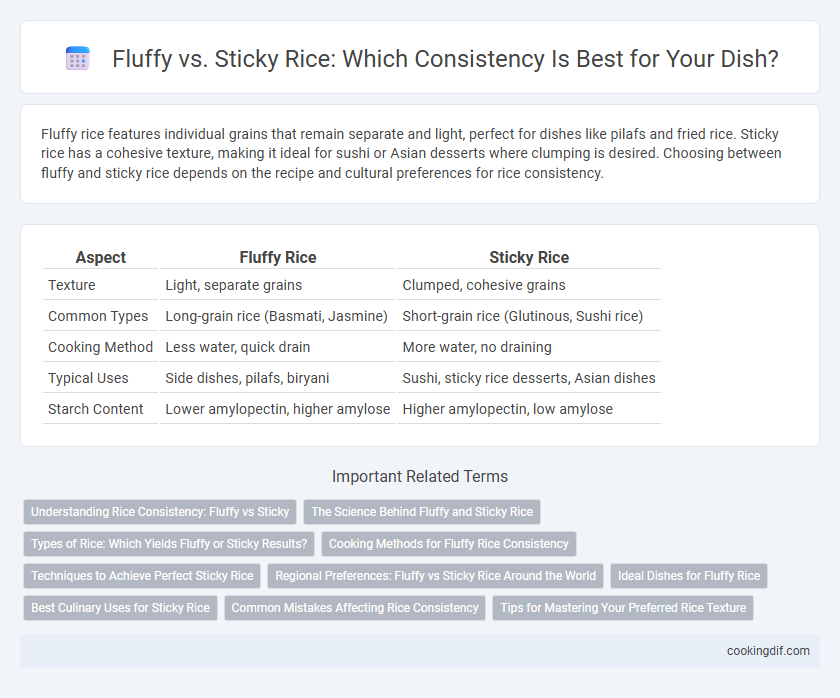Fluffy rice features individual grains that remain separate and light, perfect for dishes like pilafs and fried rice. Sticky rice has a cohesive texture, making it ideal for sushi or Asian desserts where clumping is desired. Choosing between fluffy and sticky rice depends on the recipe and cultural preferences for rice consistency.
Table of Comparison
| Aspect | Fluffy Rice | Sticky Rice |
|---|---|---|
| Texture | Light, separate grains | Clumped, cohesive grains |
| Common Types | Long-grain rice (Basmati, Jasmine) | Short-grain rice (Glutinous, Sushi rice) |
| Cooking Method | Less water, quick drain | More water, no draining |
| Typical Uses | Side dishes, pilafs, biryani | Sushi, sticky rice desserts, Asian dishes |
| Starch Content | Lower amylopectin, higher amylose | Higher amylopectin, low amylose |
Understanding Rice Consistency: Fluffy vs Sticky
Fluffy rice grains remain separate and light, ideal for dishes requiring distinct texture such as pilafs or fried rice, primarily achieved using long-grain varieties like Basmati or Jasmine. Sticky rice clumps together due to higher amylopectin content, common in short-grain or glutinous rice, perfect for sushi, Asian desserts, or eating with chopsticks. Controlling water ratio, cooking method, and rice type is essential to mastering desired consistency and enhancing dish authenticity.
The Science Behind Fluffy and Sticky Rice
Rice consistency depends on the amylose and amylopectin content within the grain, which influences its texture after cooking. High amylose rice varieties result in fluffy, separate grains due to lower starch gelatinization, while high amylopectin varieties yield sticky, clumped rice because of increased starch gelatinization and retrogradation. Precise water-to-rice ratios and cooking methods further manipulate the balance between fluffy and sticky textures, grounded in rice starch chemistry.
Types of Rice: Which Yields Fluffy or Sticky Results?
Long-grain rice, such as Basmati and Jasmine, typically yields fluffy and separate grains due to its low amylopectin content and high amylose levels. Medium-grain rice varieties, like Calrose, strike a balance between fluffiness and stickiness, often used in dishes requiring slightly clumped rice. Short-grain rice, including sushi rice and Arborio, contains more amylopectin, resulting in sticky, cohesive textures ideal for sushi and risotto.
Cooking Methods for Fluffy Rice Consistency
Achieving fluffy rice consistency involves using methods such as rinsing the rice thoroughly to remove excess starch, employing the absorption cooking technique with precise water-to-rice ratios, and allowing the rice to steam covered after cooking for 10-15 minutes. Utilizing long-grain rice varieties like Basmati or Jasmine supports fluffiness due to their lower amylopectin content compared to short-grain types. Cooking with a heavy-bottomed pot and avoiding stirring during cooking prevents clumping, ensuring separated, fluffy grains.
Techniques to Achieve Perfect Sticky Rice
To achieve perfect sticky rice, rinsing the rice thoroughly until the water runs clear is essential to remove excess starch and prevent clumping. Soaking the rice for at least 30 minutes before steaming enhances its gelatinous texture, allowing the grains to adhere properly. Using a bamboo steamer and gentle, consistent heat ensures even cooking, producing the characteristic sticky consistency preferred in many Asian cuisines.
Regional Preferences: Fluffy vs Sticky Rice Around the World
Fluffy rice, characterized by separate, airy grains, is preferred in regions like North America, Europe, and parts of the Middle East, where dishes such as pilaf and biryani highlight this texture. Sticky rice, known for its clumped, adhesive quality, dominates in East and Southeast Asia, including countries like Japan, Thailand, and Laos, where it is essential for sushi, sticky rice desserts, and traditional meals. Cultural culinary practices and local rice varieties, such as Japonica for sticky rice and long-grain Indica for fluffy rice, strongly influence these regional preferences.
Ideal Dishes for Fluffy Rice
Fluffy rice, characterized by separate, dry grains, is ideal for dishes such as pilafs, fried rice, and biryanis where distinct grain texture enhances the overall experience. Long-grain varieties like Basmati or Jasmine are preferred for fluffy consistency due to their lower starch content, which prevents clumping. This rice type complements savory meals that benefit from a light, airy texture, making it essential for stir-fries, curries, and grilled meat accompaniments.
Best Culinary Uses for Sticky Rice
Sticky rice, also known as glutinous rice, is prized for its soft, chewy texture that clumps together, making it ideal for dishes like sushi, rice cakes, and dim sum. Its high amylopectin content creates a naturally adhesive consistency, perfect for recipes requiring rice to hold shape or be molded. Cooks often choose sticky rice for traditional Asian desserts, steamed rice dishes, and as a staple accompaniment to savory meals that benefit from its unique mouthfeel.
Common Mistakes Affecting Rice Consistency
Common mistakes affecting rice consistency include using the wrong rice variety, such as opting for long-grain rice when sticky texture is desired, or short-grain rice when fluffiness is the goal. Overcooking or using too much water often results in sticky rice, while insufficient water or undercooking can produce dry, crumbly grains lacking fluffiness. Neglecting to rinse rice before cooking leads to excess surface starch, causing unwanted stickiness in fluffy rice preparations.
Tips for Mastering Your Preferred Rice Texture
Achieving fluffy rice begins with rinsing grains thoroughly to remove excess starch and using a precise water-to-rice ratio, typically 1.5 to 1 for long-grain varieties. For sticky rice, soak medium or short-grain rice beforehand and slightly increase water absorption to encourage starch release and adhesion. Controlling cooking time and proper resting allows rice to reach desired texture, with fluffiness enhanced by gentle fluffing with a fork and stickiness preserved through minimal stirring.
Fluffy vs Sticky for rice consistency Infographic

 cookingdif.com
cookingdif.com